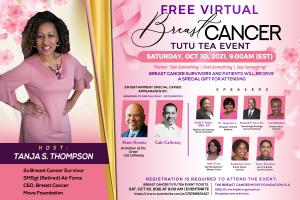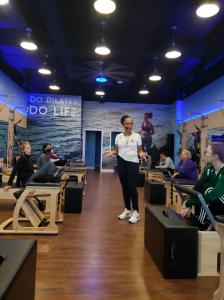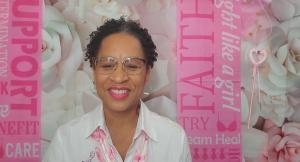Breast Cancer and African American Women:Why Disparities and What to Do? Attend the Free Virtual Breast Cancer Tutu Tea
Breast Cancer doesn't discriminate. Hear from survivors, a son, a Doctor, Nurse Practitioner talk about the devastation and triumph of this diagnosis.
LEESBURG, VA, UNITED STATES, October 25, 2021 /EINPresswire.com/ -- According to the American Cancer Society, breast cancer is the second major cause of cancer deaths among women in the United States. African American (AA) women have more than a 40% chance of dying of cancer than white women. This startling disparity in death can be attributed to a persistent disparity in treatment and access for Black women and has been worse than ever with the ongoing raging pandemic. It is made more startling of a statistic that is far too often glanced over with COVID.Tanja is a 2xbreast cancer survivor, diagnosed in 2005 and again in 2010. As a founder of The Breast Cancer Move Foundation, a 501c3, I often wonder if I am doing enough to mitigate the rate of this cancer in Black women.
Why do these disparities exist? If we want to understand this, we need to consider some prime issues. The first issue is related to social structure. A recent study published in the ASCO Publication explains that socioeconomic condition contributes to AA women's higher breast cancer mortality rate. Poverty, unemployment, and mistrust of health professionals is expected in the African American community.
For instance, Henrietta Lacks, in 1951, was diagnosed with cervical cancer at John Hopkins Hospital, one of the few hospitals that would treat poor AA. Upon examining her cancer tissue cells, doctors immediately recognized their unique density to replicate every 20 to 24 hours. As her tissue cells helped so many others, she died of an aggressive form of cervical cancer that same year, she was only 31 years of age. Without her consent or acknowledgment, her cells were distributed and used within the medical and scientific community.
Her cells, nicknamed "HeLa" cells, are being used to treat cancer, toxins, effects of radiation, and as of recent, the COVID-19 vaccine. People who are low-income lack adequate access to treatment for several ailments. In any cancer, early detection is paramount. It saved my life twice. Having better treatment can help a person detect the presence of breast cancer at an early stage. So, the social structure makes a difference.
The second issue are structural racism and equity, which translates to lack of healthcare access, high-cost treatment, inability to navigate the convoluted medical red-tape to obtain treatment. The article mentioned in the previous paragraph also highlighted this factor. Yes, even in 2021, we are talking about it! We all are aware of what's happening inside U. S. regarding black lives. Because of continuous racism, lack of equity, and mistrust of medical authorities, African Americans make up a small number in clinical trials (1% to 3%) even though they are more likely to die from breast cancer than white Americans.
The third major issue is the unbalanced lifestyle in the African American community.
A study published in 2018 in the Nature Portfolio Journal indicates the habit of long-term tobacco smoking, obesity, alcohol consumption, hypertension, and lack of physical activity in raising the risk of death from breast cancer among the African American community. According to the American Cancer Society, AA women are more likely to have a Vitamin D deficiency, have children at a younger age, live in segregated and dense communities, experience discrimination from a health care provider, and are often diagnosed with triple-negative breast cancer than white women.
The COVID-19 pandemic is a new factor that makes the overall scenario more volatile. It has increased undesirable challenges almost in all sectors, especially in public health and the economy. This pandemic has made people unemployed all over the country. As a result, there is less opportunity now for people to access better treatment facilities. Women are also delaying in scheduling their annual mammograms. The Study ASCO Publication mentioned in previous paragraphs has estimated 10,000 deaths resulting from breast and colorectal cancers by the year 2030 due to adverse effects caused by this deadly pandemic.
Since we've discussed problems now, I must provide possible solutions to make this as less severe as possible. The first thing we must do is to make quality healthcare accessible for all. Early screening of breast cancer (like a mammogram) & other treatment procedure should be within an affordable range. Secondly, we should be aware of our lifestyle behaviors.
We should consume healthy food, avoid excessive drinking and smoking, do regular exercise to maintain healthy habits. Thirdly, we need to stop racism immediately to allow people of color to participate more in clinical trials. It will help the researchers study more deeply the underlying issues of breast cancer in our community. Finally, with the help of community education (like a campaign about the benefits of early screening), we can at least attempt to mitigate the death rate.
I’m a very optimistic person. I like to dream of an America where everyone has equal access to any opportunities regardless of color & race. As I question myself every day doing, I ponder am I doing enough to educate men and women on breast cancer, I see a ray of hope in the form of the answer. A hope that keeps me alive.
A hope that constantly pushes me forward to fight for breast cancer equality, being a voice for women like Henrietta Lacks whose voice was muted.
The Free Virtual Breast Cancer Tutu Tea Event
Join us on Saturday, October 30, 2021 at 9:00am (EST)
October is Breast Cancer Awareness month, and for the majority of the world, that means lots of pink ribbons and images of smiling women with their arms around their survivor sisters, it's also 365, 1, 8, 31, 29, 40. Why?
1 in 8 women and 1 in 1,000 men will receive a breast cancer diagnoses in the United States.
Breast Cancer is more than 31 days in October its 365 days of the year.
Every 29 seconds a woman is receiving a breast cancer diagnoses.
African American women are 40% more likely to die from breast cancer and twice as likely to die if they are over the age of 50.
Tanja Thompson
Breast Cancer & Transformational Resolution
+1 301-437-9491
speak@tanjathompson.com
Visit us on social media:
Facebook
Twitter
LinkedIn
From Tragedy to Triumph that of a Breast Cancer Survivor
Legal Disclaimer:
EIN Presswire provides this news content "as is" without warranty of any kind. We do not accept any responsibility or liability for the accuracy, content, images, videos, licenses, completeness, legality, or reliability of the information contained in this article. If you have any complaints or copyright issues related to this article, kindly contact the author above.



